Existing User Log In
New User Registration
Register for a free account to gain full access to the VGChartz Network and join our thriving community.



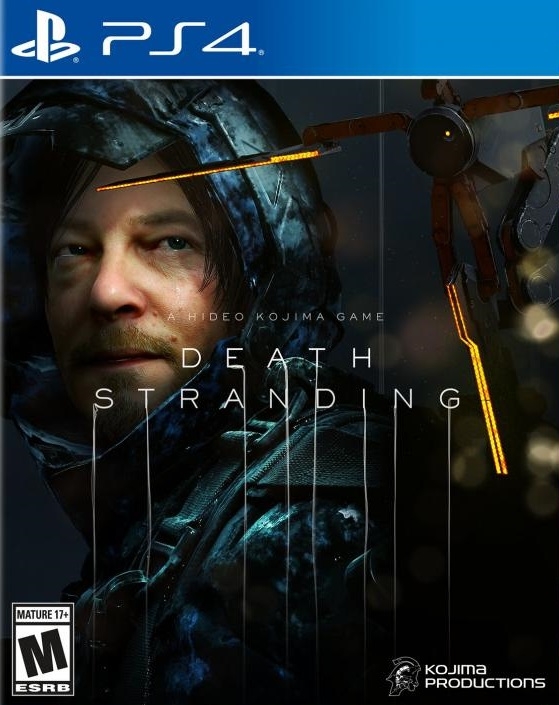

America - Front


America - Back

Few names in the games industry garner such intense reactions as that of Hideo Kojima. After departing from Konami, and the titular Metal Gear Solid IP tied to them, the popular designer/writer found himself in a different situation: founding a new studio. Although putting the pieces together to explain what Death Stranding is about requires some mental effort, an easy judgment to make is it being a developer-driven blockbuster through and through. While it’s a nice contrast from the corporatized expectations that can wriggle into good titles, this also means my frustrations at this polished trainwreck get directed towards one source.
Continuing onto my frustrations wouldn’t do any good without explaining the game. So, what is Death Stranding?
You play as Sam Porter Bridges (starring Norman Reedus), a freelance delivery man in an apocalyptic America. This isn’t the result of nuclear devastation; instead, it’s the result of the “Death Stranding,” a cataclysmic phenomenon that resulted in ethereal creatures (called BTs) invading. This, along with other concomitant effects, ravaged America to the point of most survivors holding up in underground enclaves, known as “Knot Cities.” Upon learning about his sister’s plan to reconnect America and her current captivity by a terrorist cell, the recalcitrant protagonist sets off to the West Coast in a bid to save Amalie and also reconnect everyone under the United Cities of America’s (UCA) new communications system: The Chiral Network.
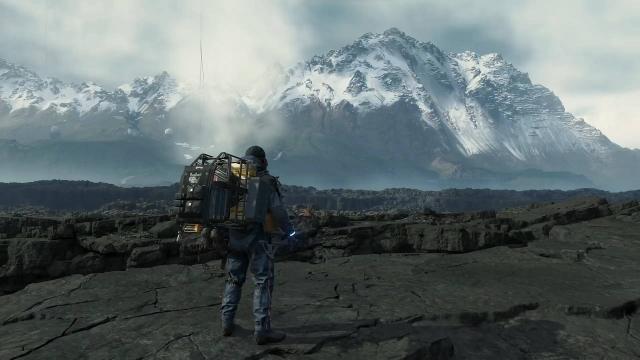
Again, what the hell is Death Stranding?
There’s a lot to take in. Effectively, you’re the equivalent of Costner’s “The Postman”, growing in legendary status by completing A-to-B fetch quests. The core of the game is simply traversing the environment and overcoming whatever obstacles may come your way, be it the climate, the often-difficult terrain, the insane MULEs obsessed with taking any porter’s cargo as their own, or the previously mentioned BTs. What’s birthed from this rudimentary core is one of the most obnoxiously designed games of recent memory.
The idea of using tools and intuition to conquer steep inclines sounds appealing on its own, but what Death Stranding adds is a specific, constantly-obtrusive physics system wherein any modest turn made whilst managing packages requires you to rebalance with the R2 or L2 button, or continuously hold both at the sacrifice of speed. The mere act of scaling terrain has now been turned into those hackneyed tightrope-walking segments in adventure games. There is one particular segment in the beginning where the hiking template captures the meditative mood I believe they were going for: tackling the best route forward using Sam’s “Odradek” scanner and map whilst listening to a licensed track by Low Roar, Chvrches, or some other band you’re likely to hear in an independent coffee shop.
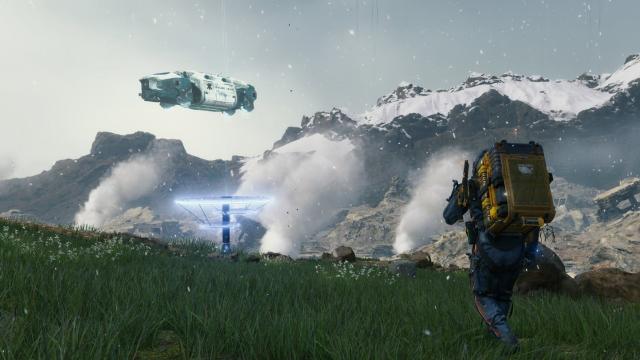
Since I tried to remain in the dark (as well as one could), I had hoped that calmer sensation would take up a bigger chunk of gameplay; instead, the next gameplay-focused bit of hauling someone was the first time I considered quitting the game outright. Hell, even Kojima has admitted just how slow of a burn it is until arriving at the meat of the game. The obtrusiveness of balancing becomes even more pronounced during the title's stealth portions with BTs. Thanks to Sam’s BB, a premature child confined into a large pickle jar, your scanner is able to detect the distance of these ghosts. Should you get too close, you’ll have to hold your breath lest they start stomping towards you. Getting caught results in trudging through muck while black-goo people pull you down; their success results in a fowl monstrocity attacking you.
All of these conditions are still considered within the frustrating balancing system; further, should your BB get too upset it’ll keep crying and crying, demanding you soothe it (via motion controls by default). Always at the worst time, a tumble will transpire and all these annoying aural elements are going off: the Odradek’s whirling sound queues, the stupid pod-baby crying (through Dualshock 4’s awful controller speaker by default), the BTs stomping, background noise, and on and on. When the gameplay isn’t pestering you with your Amazon delivery job it’s infuriating you with part-time babysitting mechanics.
Then what compelled me to move forward? Aside from the—regrettable—decision to opt for reviewing it, eventually a break comes when items are added, which allay the early-game nonsense. A battery-powered bike becomes available, the gradual buffs as your transporter ranking levels up, new exo-skeleton abilities, and so on give credence to the courier-sim gameplay having a dense amount of interacting systems. Although I came to find about one-third of said tools useless to my playstyle, the variety still shows it wasn’t a mere afterthought. During its... better moments, the times I fell over seeing my items fly out and tumble away did lend itself to me caring which (if any) were damaged beyond repair and how that might impact my future travel decisions.
Though the sting of certain defeats is well-realized, the same can’t be said for your successes. Considering how many mainline quests there are, all that’s really accomplished when reaching a destination is going to the terminal, completing the order via menu prompts, and watching a hologram thank you—along with watching the same unloading cutscene you’ll eventually skip past. It’s especially weird not seeing anyone face-to-face, despite Knot City populations in the thousands. The only tangible change you get to see is a visual upgrade to the hologram after plugging them into this new-age internet, and some text dumps via Sam’s email. Delivering a cart of Monster-branded energy drinks or crates of sperm doesn’t mean I suddenly care about that person’s history lesson, their afternoon, or the rare Trump allusion they wish to make. The one email chain I cared about was a couple’s relationship because they had dedicated cutscenes and you personally interacted with them, however briefly.
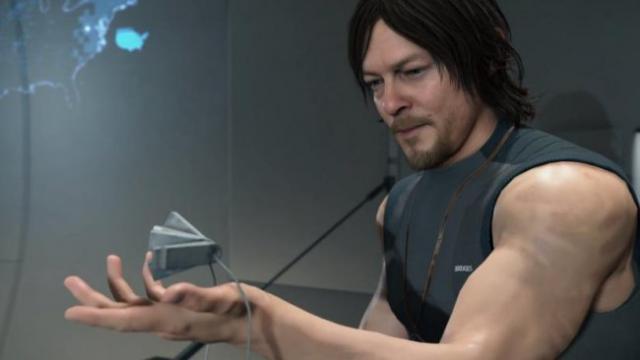
Even though playing porter is the meat of Death Stranding, it indulges itself with shooting from time to time. Combat is a joke. You’ll be transported to some nice locations, but it’s mechanically pared down to the absolute basics. Even ammo is automatically paired with the weapon crate you picked up. If you plan to play on Hard difficulty then enjoy the dull bullet-sponge boss battles. Every monster is just a battle of attrition as you utilize Sam’s piss grenades and blood-covered bullets to peck away at its health. So now you’re balancing on an oil-drenched battlefield, dealing with a boss’s upcoming move, and flipping through menus to grab your next gun or refill health with a blood bag. Dozens of hours dedicated to overcoming environmental obstacles only to fall back on monotonous combat galleries towards the end.
Bobbing back up for air on a positive would be the asynchronous multiplayer aspect. For a game whose motif centers on connectedness, players’ actions influencing your world in small or dramatic ways is a solid concept. Whether it’s adding materials to pave a road, dropping holographic logos that encourage you to move forward, fabricating new bridges, or setting down ladders, there are a plethora of methods to assist other sojourners. But this isn’t automatic when starting the game. Only after a newly connected city, or “Strand,” is established does the surrounding area reveal baubles and tools from other players. It’s interesting to see this disparate design emphasis from another trend-setter like Demon’s Souls echoed here (it so happened to turn ten years old last month).
As much as I still credit the conceit, I’m also not going to brush past one countervailing sensation: the best part about the assistance is the hours of drudgery I got to avoid. Other players’ zip lines, vehicles, and bridges didn’t so much buttress a solid foundation as they did partially alleviate the mind-numbing tedium and annoying expanses of the snow biome. Being late to the party enabled me to leech off the effort of some poor soul who had to climb up that mountain first. There are several bullshit orders that would’ve made me quit outright were online players absent. To end with a corny Kojima-ism: online was the strand that kept my sanity intact.
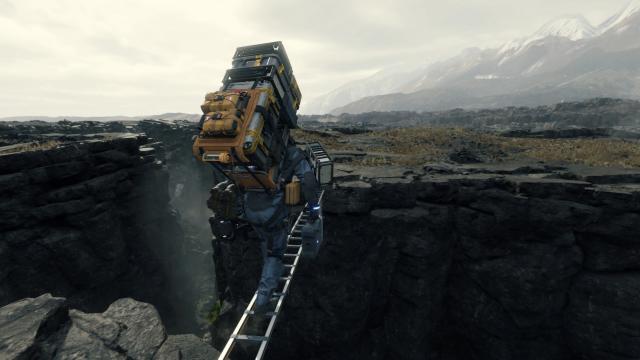
There are multifarious design elements I’ve not touched on that contribute to my greater frustration. The flexibility in handling MULEs didn’t matter to me because I just preferred using the satisfying BOLA gun; no other tactic besides running away felt worthwhile. The inconsistency with how quickly the muck men overwhelm and drag you felt specifically designed to piss the player off. Vehicle handling seems deceptively better in the first cutscene than in-game. Even your private quarters, which you'll constantly visit to replenish stamina, aren't safe from the obnoxious incoporation of recycled shower & bathroom cutscenes. Since refreshing yourself replenishes your grenade stockpile, you're pushed to do this and skip past these videos over and over again.
All of this and more contribute as to why I abhorred much of this gameplay. I can imagine myself understanding someone else detailing the abstract qualities Death Stranding utilizes to challenge preconceived notions or whatnot. I’m capable of intellectually considering those arguments, but I’ll never be able to connect with them after fighting these intrusive mechanics for hours on end.
For a game so focused on connection, it’s shocking just how detached I felt for most of the story too. Just as the mechanics are punishing, the opening salvo of world-building jargon is overwhelming in its extent. Now, it’d be fair to compare how SCP Foundation informed the lore-heavy weirdness in Control’s beginning. But do you know how that was managed? Roughly a half-hour in and you get to sit down with someone (Emily Pope) and probe her for explanations. Conversely, Death Stranding is not so quick to inform; in fact, its primary objective seems to be over-expositing granular details to Sam (i.e. you) before you feel situated.
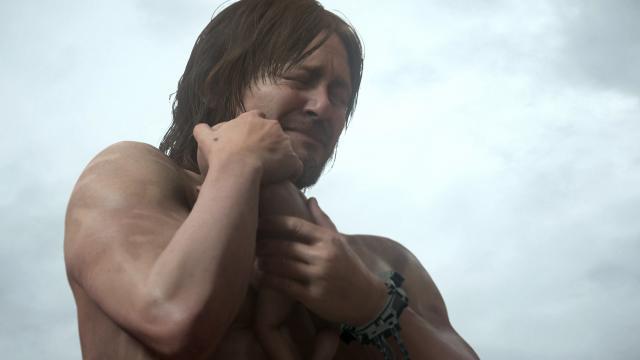
It still blows my mind just how fixated Kojima is on reiterating such a simple idea as ‘reconnecting America’ to Sam over and over. The rare meditative moments you’re trying to have are undercut by failed Mega Man villain name “Die-Hardman” repeating your importance to the grander narrative. Even some of Death Stranding’s most evocative scenes can’t escape this blunt-force trauma. To avoid giving away direct spoilers: an emotional scene for a side-character happens around the mid-way point. Right after this cutscene finishes, an optional email by the Knot City operator spells out the visual metaphors of that character in exhaustive detail. Who are you to rob me of that moment?
That thin line between blunt or overbearing messages is one Kojima’s never shy to cross. It’s one of those “Kojima-isms” I’ve often looked past with the mainline Metal Gear series, but the overabundance I’m detailing here runs on for nearly 40 hours. The sheer overuse dampens those visually sumptuous moments whenever a new gadget or world-building concept I like is introduced. What are these handprints all over Sam? What’s this baby shoved down Norman Reedus’s throat giving me a thumbs-up? How did Mads Mikkelsen become the guy who occasionally cries a substance other than tears? The fiendish-madman quirks baked into Kojima’s socio-political contemplations are weighed down by the oily morass of ostentatious dialogue often stuck in a cul-de-sac.
Even with the interesting world, I think this retinue of characters is the least enjoyable in a Kojima game that I’ve played—Solid (1) through Solid 4. Not to say there are no redeeming qualities. As far as voice actors/actors go, the roster is an impressive list of professionals across various mediums. I respect the array of choices, but my contention comes down to—once again—the material and uneven direction. I’m not sure what good it does to hire Norman Reedus as a paint-by-numbers hardass for most of the game. Tommie Earl Jenkins owns his role during the conclusion, while Troy Baker chews—sometimes licks—the scenery as the one-dimensional bad guy. But in this effort of limiting the campy attitudes of Kojima’s previous, many character interactions here feel insipid as a result.
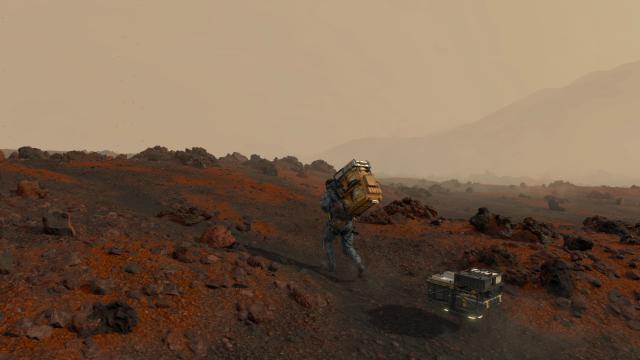
One of the few things I can say without any reservation is Death Stranding’s story is wholly driven by the artists behind it; not a jot or tittle suggests corporate involvement. But that can carry the risk of unrestraint. From encyclopedias worth of written/spoken words that felt so uninteresting, to one of the most pretentious endings in respect to game design & exposition, this is the quintessential example of mishandled execution.
All of this critiquing isn’t easy to say, especially for a title that looks so exceptional at nearly every point. One of Death Stranding’s proudest proclamations pre-release was it being powered by The Decima Engine. And, unlike my rough experiences with Days Gone, the lack of any technical annoyances (framerate in particular) at launch suggest Kojima Productions did their due diligence with the base PS4. World design feels hand-crafted despite feeling so expansive. The way grassland, rocky, and snowy terrain are all incorporated do make sense for the gameplay loop they were going for. The layout of the world map is fresher in my memory than parts of the narrative or game design. Aside from minor nitpicks like the sameness of constructed locales and some character animation issues, the specific aesthetic of its world and sci-fi accessories makes it worthy of end-of-year nominations.
One could make the argument for that as well with respect to sound design & soundtrack. I’m almost certain Kojima bought all of Low Roar’s current discography to utilize during those tranquil moments. The rest of the indie bands as well round out for an incredible mixture of licensed and original scores. The only other developer I recall placing this level of attention into their open world titles would be Rockstar North with the GTA series. Death Stranding’s greatest sins simply come back to those moments of maximalist aural design; the disparate actions going on at once, the annoying boo-wee-bu-wee-do radio calls with Die-Hardman saying “we’re all counting on you,” or the robotic howls of a MULE spotting you. One could defend each element’s purpose, but it just sounds like an overproduced cacophony to me.
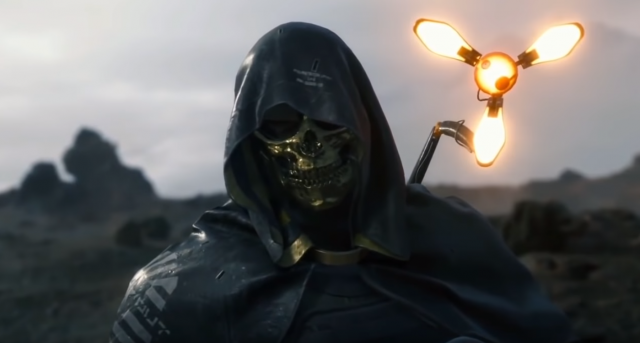
Instead of serving as a heterodox example of untrammeled artistic freedom to celebrate, Death Stranding winds up being a cautionary tale. Is the game unique? I’d say it qualifies as that, yes. But after tackling its bumbling, sometimes-contradictory gameplay until completion (40 hours), all that translates to for me is it being a uniquely annoying time. Coming from someone who can find engagement in protracted Codec conversations, I’m still stunned at how tiresome this game’s story tends to be. There’s incredible tech and nuanced online features behind this game, but those only mitigate my irritation. If leaden pacing, meddlesome gameplay, and turgid storytelling is Kojima’s way for us to “build bridges” with one another, I’d rather have the wall be ten feet higher.









